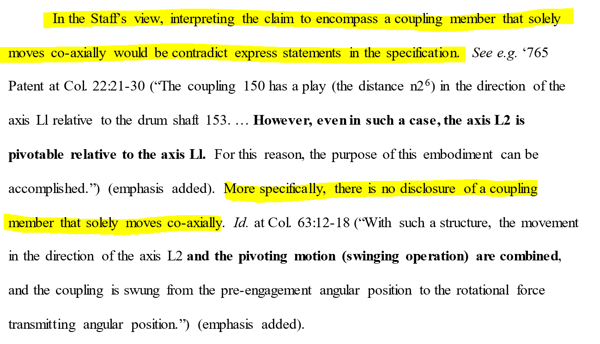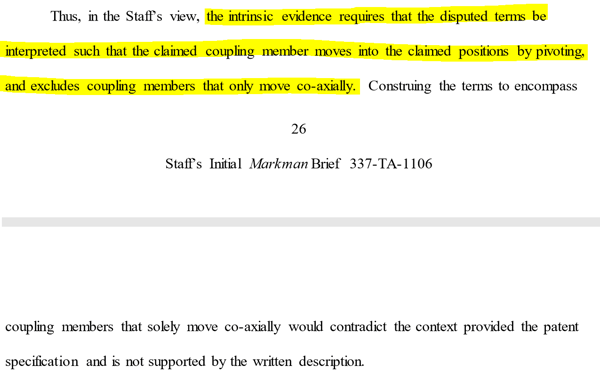Almost five months after the Canon complaint was lodged with the ITC back on February 28, 2018, a significant development occurred last Friday, July 27, 2018, with the issuance of the ITC Staff's brief in preparation for the Markman hearing on claim construction that's scheduled to take place August 30, 2018.
We previously published a blog on the decision to include a Markman hearing as part of the Investigation, which included an explanation of what would be involved.
ALJ Sandra (Dee) Lord, who was assigned the case, has precedent to favor including a Markman hearing as part of an investigation, as opposed to ALJ Shaw, who handled the previous Canon complaints (Cases '829 & '918 from 2012 and 2014, respectively), who did not.
While the Markman hearing may have implications for any validity challenge to the asserted patents, it is chiefly concerned with the (non) infringement issue. It presents an opportunity for the Complainant (Canon) to present its case for explaining to the ALJ the patent claims to support its infringement allegations and for the respondents to give theirs in a way that promotes their non-infringement defense.
What just happened?
As part of the process leading up to the Markman hearing on August 30, 2018, the following three filings have just taken place:
- July 26, 2018 - Respondent's Initial Markman Brief
- July 26, 2018 - Canon's Initial Markman Brief
- July 27, 2018 - Commission's Investigative Staff's Initial Markman Brief
The issue for the Markman hearing is determining how the asserted patent claims should be interpreted, an essential milestone in the Investigation.
The Complainant (Canon) takes the position that the "plain language" of the claims encompasses "axial only" movement (movement of the coupling member in the direction of the long axis of the drum unit) and should not be limited to pivoting (inclination of the coupling member away from the long axis of the drum unit) since the key to their original invention is having a coupling incline or pivot to permit insertion of the cartridge into the printer without having to move the drive shaft.
The Respondents believe the claims should be limited to pivot or incline couplings. They should not be interpreted to cover collars that move in and out, co-axially only, without riding, as incorporated in their redesigns.
Both Canon's position and the Respondent's position were previously and publicly established (in the case of Canon) by way of the initial filing of the complaint and (in the case of the respondents) by way of their initial replies to the complaint. Therefore, the basis of the two sides' arguments for and against infringement was already b, broadly understood.
So, what we're particularly interested in is the Staff's brief because, up to this point, it has been unknown how the attorneys of the Commission Staff (which is a party to the Investigation with the mandate to protect the "public interest") may view the two opposing positions. This document provides us with a clear indication of which argument the Staff leans toward.
That said, it should be noted that the ITC Staff is a neutral third party whose position is often persuasive to, but never binding on, the ALJ and the Commission.
Reply briefs are due from the parties by August 16, 2019, and once the Markman hearing itself has taken place, there is a precedent in ALJ Lord's history of ITC investigations that a Markman hearing order may be issued. Should this be the case, we expect it to be published sometime after the projected date for completion of the expert discovery (September 29, 2018) and in advance of the trial scheduled to start on January 29, 2019.
What does the Staff's Brief say?
In short, the Staff has repudiated the entire premise of the '1106 Investigation requested by Canon. It has dismissed the notion that Canon can write new patents claiming priority to a patent originally written to cover a gear that inclines so that the new patents cover a bag that does not bend.
Extract from Page 25 of the Staff's Brief:

Excerpt from Page 26 of the Staff's Brief:

The new patents that Canon obtained (nine of which were introduced to the '1106 Investigation) cover all the respondent's designs that were presented to avoid the claims of the patents asserted in the 2014 '918 ITC investigation.
The Staff's views appear highly persuasive, and the position outlined in the Staff's Markman brief, if adopted by the ALJ and the Commission, will ultimately end the case with a defeat for Canon.
However, even if ALJ Lord issues a Markman hearing order before the trial, regardless of whether such an order was to agree with the Staff's brief, it would not affect Canon's ongoing right to see out the Investigation. Never mind how damaging a potential Markman hearing order may be (should it agree with the Staff's claim construction brief), unless Canon decides to enter into settlement discussions with the Respondents that are subsequently concluded to all the party's satisfaction, the Investigation will proceed, and the trial will take place.
At the trial, regardless of the Staff's brief and a potentially adverse Markman hearing order, Canon will present its evidence of infringement based on its claim construction, just as the Respondents will do for theirs. Canon will do this to place its arguments for its claim construction (and thereby its infringement case) on the record as necessary for a potential appeal should its complaint not be upheld.
An Initial Determination from ALJ Lord will follow the trial, and even if this agrees with the Staff brief (and a potential Markman order agreeing with the Staff's brief), it must be understood that this would still only be an Initial Determination.
There will be a four-month gap between the Initial Determination (March 29, 2019) and the Final Determination (July 29, 2019). During this four-month gap, it is logical to assume that Canon would petition the full Commission to review and try to reverse an adverse Initial Determination. Furthermore, even taking the Commission upholds the ALJ on this fundamental point, Canon still has the right to appeal the Final Determination to the United States Court of Appeals for the Federal Circuit (CAFC).
What are the implications?
When the '1106 complaint was filed on February 28, 2018, it resulted in adverse developments for the aftermarket new-build design-around cartridge manufacturers and their customers.
- Insinuations in various publications that the accused cartridges were no more than "copycat" clones.
- At least one prominent OEM is taking the opportunity to remind resellers of the risks of selling infringing cartridges and the impact that continued sales may have on authorizations to sell their OEM-branded cartridges.
- A strongly worded letter was sent to the members of a leading Buying Group that signaled the withdrawal of support for specific new-build design-around cartridges.
As a result, the prospects for new-build design-around cartridges continuing to build market share in established distribution channels took a significant turn for the worse. Furthermore, regardless of the eventual outcome of the '1106 Investigation, immediate damage to the brands and the reputations of the new-build design-around manufacturers and their resellers occurred.
We have consistently taken a "black and white" view that because new-build design-around cartridges are less expensive to manufacture than remanufactured cartridges and because, at least in theory, they should be higher quality than remanufactured cartridges because they only contain new parts, new-build design-around cartridges will eventually eliminate remanufactured cartridges from the market.
Even after the onset of this latest round of litigation, our view on this position did not change as we believe the well-capitalized, predominantly Chinese, new-build design-around manufacturers have sufficient financial and technical resources to continue to redesign components they are accused of infringing which, in turn, would ensure business ultimately continued as usual.
Normal, however, is the key word here because recent "normal" for new-build design-around cartridges has been a continuous cycle of litigation that has fed campaigns (initiated by those with the most to lose) to spread fear, uncertainty, and doubt that have served their purpose in limiting their market penetration. However, should the ALJ and the Commission ultimately agree with the Staff's claim construction brief, the historical reluctance of the more prominent players to introduce these design-around products to the distribution channels, a significant part of which has been cultivated by fear, uncertainty, and doubt, may change.
Again, should the Commission ultimately agree with the Staff's arguments, this Staff brief may prove to be a tipping event in the eventual outcome of the three-sided battle for share in the market for toner cartridges.
Conclusion:
On balance, we have to assume that, regardless of the Staff's brief on the claim construction and irrespective of a potentially damaging Markman hearing order, the chances are that Canon will not settle the dispute with the Respondents (at least not with all of them) and that the Investigation will proceed through trial and the Initial, and Final Determinations.
However, should the claim construction remain consistent with the Staff's brief throughout the remainder of the Investigation, then there's the potential for a humiliating loss for Canon that's unlikely to have been anticipated as a probable outcome by any of the parties involved in the Investigation - not least by Canon itself who may eventually lose the ability to enforce a handful of patents and thereby also be encouraged to consider its future litigation strategies very carefully.
For the Respondents, while the Staff's brief is unquestionably a positive development that favors their argument, it is not a final determination because ALJ Lord and the Commission may disagree with the claim construction laid out in the brief.
With great interest, we will monitor a potential Markman hearing order in the October 2018 time frame to learn if the outcome of the hearing itself may support the Staff's brief on claim construction.
